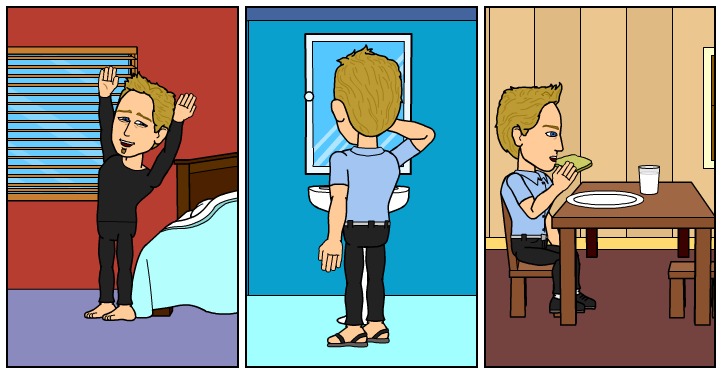Lesson 6
In this lesson, you’ll learn:
VOCABULARY AND PHRASES
- Talking about time
- Daily routines
GRAMMAR:
- Ordinal numbers
- Locative case
First make yourself familiar with ordinal numbers. Note that they are inflected by gender and they generally behave like adjectives.
Related interactive test: Ordinal numbers.» take the interactive test Related interactive test: Ordinal numbers - gender.» take the interactive test
Now as you have learned the ordinal numbers, read the following article:
Related interactive test: Talking about time.» take the interactive test Related interactive test: Time - listening.» take the interactive test

Listen to Tomek answering poll questions about daily routines.
X: Tomek, pracujesz jako architekt, prawda?
T: Zgadza się.
X: Pracujesz w domu?
T: Nie, pracuję w biurze w centrum miasta.
X: Wstajesz wcześnie?
T: Zazwyczaj wstaję o wpół do siódmej. Ubieram się, myję zęby i golę się. Później jem śniadanie.
X: Jeździsz do pracy autobusem?
T: Jeżdżę samochodem.
X: Jak długo pracujesz?
T: Od ósmej do szesnastej, a o dwunastej mam przerwę.
X: A co robisz po pracy?
T: Gotuję obiad razem z żoną. W poniedziałki jeździmy na zakupy. Wieczorem czytam gazety, a około ósmej jemy kolację. Moja żona lubi telewizję, ale ja wolę książki. Czasami chodzimy też na spacer.
X: O której chodzisz spać?
T: Kładę się zazwyczaj o jedenastej.
X: A co robisz w weekendy?
T: W weekendy odwiedzamy rodzinę albo przyjaciół.
|
pracować jako |
to work as |
|
|
Zgadza się. |
That’s right. |
|
|
w domu |
at home |
|
|
w centrum miasta |
in the town centre |
|
|
wstawać |
to get up |
|
|
ubierać się |
to get dressed |
|
|
myć zęby |
to brush teeth |
|
|
golić się |
to shave |
|
|
wcześnie |
early |
|
|
później |
then, later |
|
|
autobusem |
by bus |
|
|
samochodem |
by car |
|
|
Jak długo |
How long |
|
|
od …. do …. |
from ………. to …….. |
|
|
przerwa |
a break |
|
|
po pracy |
after work |
|
|
razem z |
together with |
|
|
lubić |
to like |
|
|
jeździć / jechać na zakupy |
to go shopping (by car) |
|
|
oglądać telewizję |
to watch TV |
|
|
woleć |
to prefer |
|
|
czasami |
sometimes |
|
|
chodzić / iść na spacer |
to go for a walk |
|
|
chodzić / iść spać |
to go to bed |
|
|
w weekendy |
at weekends |
|
|
odwiedzać |
to visit |
|
|
rodzina |
a family |
|
Regular vs single actions
As it was mentioned earlier, Polish has only one present tense, but sometimes completely different verbs will be used for regular activities. Chodzić and jeździć are examples of verbs used only for regular actions, whereas iść / jechać are their counterparts for the continous aspect.
Related interactive test: Verbs for regular actions.» take the interactive test
In the dialogue you've seen some expresions pointing at location. For this purpose locative case is used - usually in combination with the preposition w (in)
Related interactive test: Locative case.» take the interactive test
Means of transport
We use instrumental case to mention the means of transport:
samochodem (by car)
pociągiem (by train)
autobusem (by bus)
tramwajem (by tram)
samolotem (by plane)
promem (by ferry)
statkiem (by ship)
łodzią (by boat)
balonem (by air-baloon)
metrem (by underground)
śmigłowcem (by helicopter)
rakietą (by rocket)
The only exception is for the vehicles / animals you sit on. Then a preposition na is used + locative
na rowerze (by bike)
na motocyklu (by motorbike)
na koniu (on horseback)
For going on foot there are two options available. One adverbial, one prepisitional, the second being more colloquial.
pieszo (on foot)
na nogach (on foot)
Related interactive test: Revision - lesson 6.» take the interactive test
 LearnPolish
LearnPolish